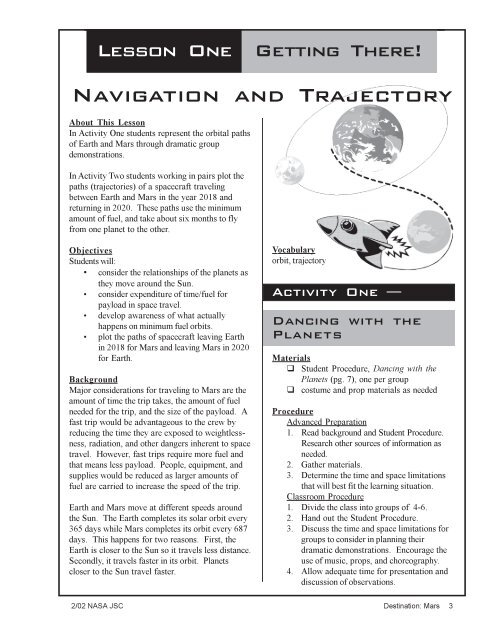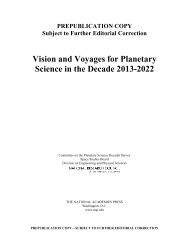Dancing with the Planets - Solar System Exploration - NASA
Dancing with the Planets - Solar System Exploration - NASA
Dancing with the Planets - Solar System Exploration - NASA
Create successful ePaper yourself
Turn your PDF publications into a flip-book with our unique Google optimized e-Paper software.
Lesson One Getting There!<br />
Navigation and Trajectory<br />
About This Lesson<br />
In Activity One students represent <strong>the</strong> orbital paths<br />
of Earth and Mars through dramatic group<br />
demonstrations.<br />
In Activity Two students working in pairs plot <strong>the</strong><br />
paths (trajectories) of a spacecraft traveling<br />
between Earth and Mars in <strong>the</strong> year 2018 and<br />
returning in 2020. These paths use <strong>the</strong> minimum<br />
amount of fuel, and take about six months to fly<br />
from one planet to <strong>the</strong> o<strong>the</strong>r.<br />
Objectives<br />
Students will:<br />
• consider <strong>the</strong> relationships of <strong>the</strong> planets as<br />
<strong>the</strong>y move around <strong>the</strong> Sun.<br />
• consider expenditure of time/fuel for<br />
payload in space travel.<br />
• develop awareness of what actually<br />
happens on minimum fuel orbits.<br />
• plot <strong>the</strong> paths of spacecraft leaving Earth<br />
in 2018 for Mars and leaving Mars in 2020<br />
for Earth.<br />
Background<br />
Major considerations for traveling to Mars are <strong>the</strong><br />
amount of time <strong>the</strong> trip takes, <strong>the</strong> amount of fuel<br />
needed for <strong>the</strong> trip, and <strong>the</strong> size of <strong>the</strong> payload. A<br />
fast trip would be advantageous to <strong>the</strong> crew by<br />
reducing <strong>the</strong> time <strong>the</strong>y are exposed to weightlessness,<br />
radiation, and o<strong>the</strong>r dangers inherent to space<br />
travel. However, fast trips require more fuel and<br />
that means less payload. People, equipment, and<br />
supplies would be reduced as larger amounts of<br />
fuel are carried to increase <strong>the</strong> speed of <strong>the</strong> trip.<br />
Earth and Mars move at different speeds around<br />
<strong>the</strong> Sun. The Earth completes its solar orbit every<br />
365 days while Mars completes its orbit every 687<br />
days. This happens for two reasons. First, <strong>the</strong><br />
Earth is closer to <strong>the</strong> Sun so it travels less distance.<br />
Secondly, it travels faster in its orbit. <strong>Planets</strong><br />
closer to <strong>the</strong> Sun travel faster.<br />
Vocabulary<br />
orbit, trajectory<br />
Activity One —<br />
<strong>Dancing</strong> <strong>with</strong> <strong>the</strong><br />
<strong>Planets</strong><br />
Materials<br />
q Student Procedure, <strong>Dancing</strong> <strong>with</strong> <strong>the</strong><br />
<strong>Planets</strong> (pg. 7), one per group<br />
q costume and prop materials as needed<br />
Procedure<br />
Advanced Preparation<br />
1. Read background and Student Procedure.<br />
Research o<strong>the</strong>r sources of information as<br />
needed.<br />
2. Ga<strong>the</strong>r materials.<br />
3. Determine <strong>the</strong> time and space limitations<br />
that will best fit <strong>the</strong> learning situation.<br />
Classroom Procedure<br />
1. Divide <strong>the</strong> class into groups of 4-6.<br />
2. Hand out <strong>the</strong> Student Procedure.<br />
3. Discuss <strong>the</strong> time and space limitations for<br />
groups to consider in planning <strong>the</strong>ir<br />
dramatic demonstrations. Encourage <strong>the</strong><br />
use of music, props, and choreography.<br />
4. Allow adequate time for presentation and<br />
discussion of observations.<br />
2/02 <strong>NASA</strong> JSC Destination: Mars 3
Activity Two —<br />
Plotting <strong>the</strong> Paths<br />
of Spacecraft<br />
Materials<br />
q Student Procedure, Plotting <strong>the</strong> Paths<br />
of Spacecraft (pg. 8)<br />
q Student Sheets, Earth to Mars and Mars<br />
to Earth (pgs. 9-10)<br />
q pencils<br />
q drawing compass<br />
q Teacher Answer Key (pgs. 5-6)<br />
Procedure<br />
Advanced Preparation<br />
1. Ga<strong>the</strong>r materials.<br />
2. Review background.<br />
3. Complete <strong>the</strong> plotting exercise for practice.<br />
Classroom Procedure<br />
1. Have students share familiar experiences<br />
that require aiming at a moving target.<br />
Their examples might be passing a football,<br />
catching a fly ball, driving vehicles in paths<br />
to avoid being hit, or playing dodge ball.<br />
Lead students to discuss <strong>the</strong> how and why<br />
of <strong>the</strong> movements.<br />
2. Have students work in pairs. They may<br />
switch jobs for each plotting exercise.<br />
3. Hand out Student Procedure and Student<br />
Sheets.<br />
Suggested Questions<br />
1. What are <strong>the</strong> orbital challenges of traveling from one planet to ano<strong>the</strong>r?<br />
2. What are some possible paths for a spacecraft traveling from Earth to Mars?<br />
3. What could make a spacecraft get to Mars faster?<br />
4. Help students become familiar <strong>with</strong> <strong>the</strong><br />
data. Check for understanding. It is<br />
essential that students understand that Earth<br />
and Mars are moving and that <strong>the</strong> slashes<br />
on <strong>the</strong> Earth orbit represent <strong>the</strong> first of each<br />
month.<br />
5. Help students plot <strong>the</strong> first date —<br />
May 11, 2018.<br />
Note: When plotting <strong>the</strong> distance from Sun point,<br />
<strong>the</strong> compass point is always put on <strong>the</strong> Sun;<br />
when plotting <strong>the</strong> distance from Earth, <strong>the</strong><br />
compass point is put in a different place each<br />
time. The point should be put on <strong>the</strong> slash<br />
mark that represents where <strong>the</strong> Earth will be<br />
located on that date.<br />
5. Make answer keys available to students so<br />
<strong>the</strong>y can check <strong>the</strong>ir work. If <strong>the</strong>ir orbits<br />
are not similar to <strong>the</strong> answer key,<br />
encourage <strong>the</strong>m to redo <strong>the</strong> procedures to<br />
find <strong>the</strong>ir error.<br />
6. Instruct students to apply <strong>the</strong> procedures to<br />
plot <strong>the</strong> return to Earth.<br />
7. Closing discussion should encourage<br />
students to think about how a six month<br />
flight effects planning trips to Mars.<br />
More background information is contained in<br />
<strong>the</strong> Destination: Mars Educational video. See<br />
pg. 2 to order.<br />
4. What are some of <strong>the</strong> problems considered by engineers and scientists as <strong>the</strong>y design trips to Mars?<br />
4 Destination: Mars 2/02 <strong>NASA</strong> JSC
Earth to Mars<br />
Teacher Answer Key<br />
2/02 <strong>NASA</strong> JSC Destination: Mars 5
Mars to Earth<br />
Teacher Answer Key<br />
6 Destination: Mars 2/02 <strong>NASA</strong> JSC
Student Procedure<br />
<strong>Dancing</strong> <strong>with</strong> <strong>the</strong> <strong>Planets</strong><br />
Student Procedure<br />
As scientists and engineers plan for travel to<br />
o<strong>the</strong>r planets, <strong>the</strong>y have to deal <strong>with</strong> some<br />
basic planetary science.<br />
A Earth and Mars move at different speeds around <strong>the</strong> Sun.<br />
A Earth’s orbit is about 150 million kilometers (km) from <strong>the</strong> Sun.<br />
A Mars’ orbit is about 200 million km from <strong>the</strong> Sun.<br />
A Earth completes a solar orbit every 365 days.<br />
A Mars completes a solar orbit every 687 days. (The difference in orbit times<br />
is about a 2 to 1 ratio Mars/Earth.)<br />
A Earth completes its orbit in shorter time because it is closer to <strong>the</strong> Sun and<br />
has less distance to travel.<br />
A Earth travels faster in its orbit. <strong>Planets</strong> closer to <strong>the</strong> Sun travel faster.<br />
Using <strong>the</strong>se facts, demonstrate dramatically <strong>the</strong> movement of Earth and Mars around<br />
<strong>the</strong> Sun. Incorporate music, costumes, and props in your demonstration for added<br />
effects. Your group may ga<strong>the</strong>r o<strong>the</strong>r information about Earth and Mars. Make your<br />
presentation scientifically accurate demonstrating as many facts as possible.<br />
2/02 <strong>NASA</strong> JSC Destination: Mars 7
A<br />
Student Procedure<br />
Plotting <strong>the</strong> Paths of Spacecraft<br />
Student Procedure<br />
1. Locate <strong>the</strong> following on <strong>the</strong> Earth to Mars Student Sheet;<br />
• Earth and Mars orbit paths • <strong>the</strong> Sun<br />
• Earth and Mars on launch date • <strong>the</strong> scale in millions of kilometers(km)<br />
• Earth and Mars on landing date • <strong>the</strong> location of Earth on <strong>the</strong> first of each month<br />
2. Review <strong>the</strong> Spacecraft Position Data Table at <strong>the</strong> bottom of Earth to Mars Student Sheet.<br />
The Data Table shows <strong>the</strong> position of <strong>the</strong> spacecraft on <strong>the</strong> first day of each month.<br />
The first column is <strong>the</strong> distances of <strong>the</strong> spacecraft from <strong>the</strong> Sun in million km.<br />
The second column is <strong>the</strong> distances of <strong>the</strong> spacecraft from <strong>the</strong> Earth in million km.<br />
Note: Remember <strong>the</strong> Earth is moving. Each month it will be in a different place.<br />
3. Plot <strong>the</strong> path (trajectory) of <strong>the</strong> spacecraft.<br />
a. Put <strong>the</strong> point of <strong>the</strong> compass on 0 on <strong>the</strong> scale and extend <strong>the</strong> angle until <strong>the</strong> pencil reaches<br />
<strong>the</strong> first distance from Sun measurement given in <strong>the</strong> Data Table (152 million km). Pick up<br />
<strong>the</strong> compass and place <strong>the</strong> point on <strong>the</strong> Sun in <strong>the</strong> diagram. Line <strong>the</strong> compass up <strong>with</strong> <strong>the</strong><br />
first date given. Strike an arc.<br />
b. Since <strong>the</strong> distance from Earth measurement is 0, <strong>the</strong> first point is where <strong>the</strong> distance from<br />
<strong>the</strong> Sun arc crosses Earth’s orbit.<br />
c. Using <strong>the</strong> second set of data, measure <strong>the</strong> distance from <strong>the</strong> Sun (155 million km) on <strong>the</strong><br />
scale <strong>with</strong> <strong>the</strong> compass. Place <strong>the</strong> compass point on <strong>the</strong> Sun and draw a circle. Measure <strong>the</strong><br />
distance from <strong>the</strong> Earth (5 million km) on <strong>the</strong> scale <strong>with</strong> <strong>the</strong> compass. Place <strong>the</strong> point of<br />
<strong>the</strong> compass on <strong>the</strong> June 1 slash mark and draw a circle. Notice that <strong>the</strong>re are two points<br />
where <strong>the</strong> circles intersect. Choose <strong>the</strong> intersection which is closest to <strong>the</strong> launch<br />
site. This intersection represents <strong>the</strong> location of <strong>the</strong> spacecraft. Label location <strong>with</strong><br />
<strong>the</strong> date (June 1).<br />
d. Repeat this process using each set of data. Each time, <strong>the</strong> intersection that is nearer <strong>the</strong><br />
launch site represents where <strong>the</strong> spacecraft is located on that date.<br />
e. Repeat <strong>the</strong>se steps <strong>with</strong> each set of measurements on a given date.<br />
f. When all 8 points have been plotted, connect <strong>the</strong> points. This line is <strong>the</strong> path <strong>the</strong> spacecraft<br />
will follow on its trip to Mars.<br />
4. Using <strong>the</strong> key, check that your line is similar to <strong>the</strong> model. If <strong>the</strong> two lines differ, find <strong>the</strong><br />
place in <strong>the</strong> process where <strong>the</strong> error occurred. Make sure you understand <strong>the</strong> process before<br />
going to step 5.<br />
5. Plot <strong>the</strong> trajectory of <strong>the</strong> return trip to Earth from Mars using <strong>the</strong> second diagram and<br />
Data Table. Follow steps 1-4.<br />
6. A minimum fuel trip between Earth and Mars takes about 200 days. Think about how this<br />
effects planning trips to Mars. Because of this long time in space, what must happen? What<br />
cannot happen? What might happen? These are <strong>the</strong> questions that mission planners must<br />
answer. What are o<strong>the</strong>r questions that might be asked about planning trips <strong>with</strong> minimum fuel<br />
orbits?<br />
8 Destination: Mars 2/02 <strong>NASA</strong> JSC
Earth to Mars<br />
Student Sheet<br />
(1)<br />
(2)<br />
(3)<br />
(4)<br />
(5)<br />
(6)<br />
(7)<br />
(8)<br />
Data Table<br />
2/02 <strong>NASA</strong> JSC Destination: Mars 9
Mars to Earth<br />
Student Sheet<br />
(1)<br />
(2)<br />
(3)<br />
(4)<br />
(5)<br />
(6)<br />
(7)<br />
(8)<br />
Data Table<br />
10 Destination: Mars 2/02 <strong>NASA</strong> JSC











